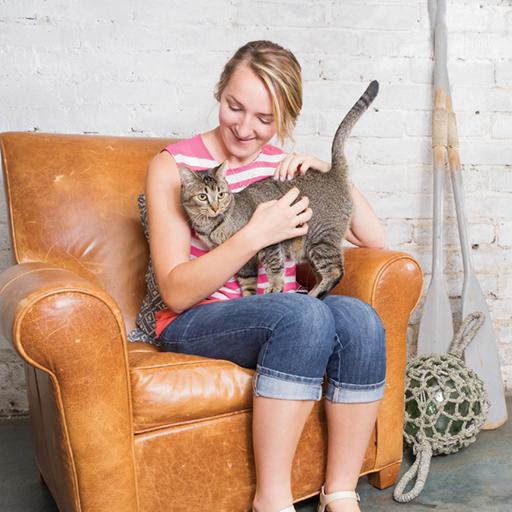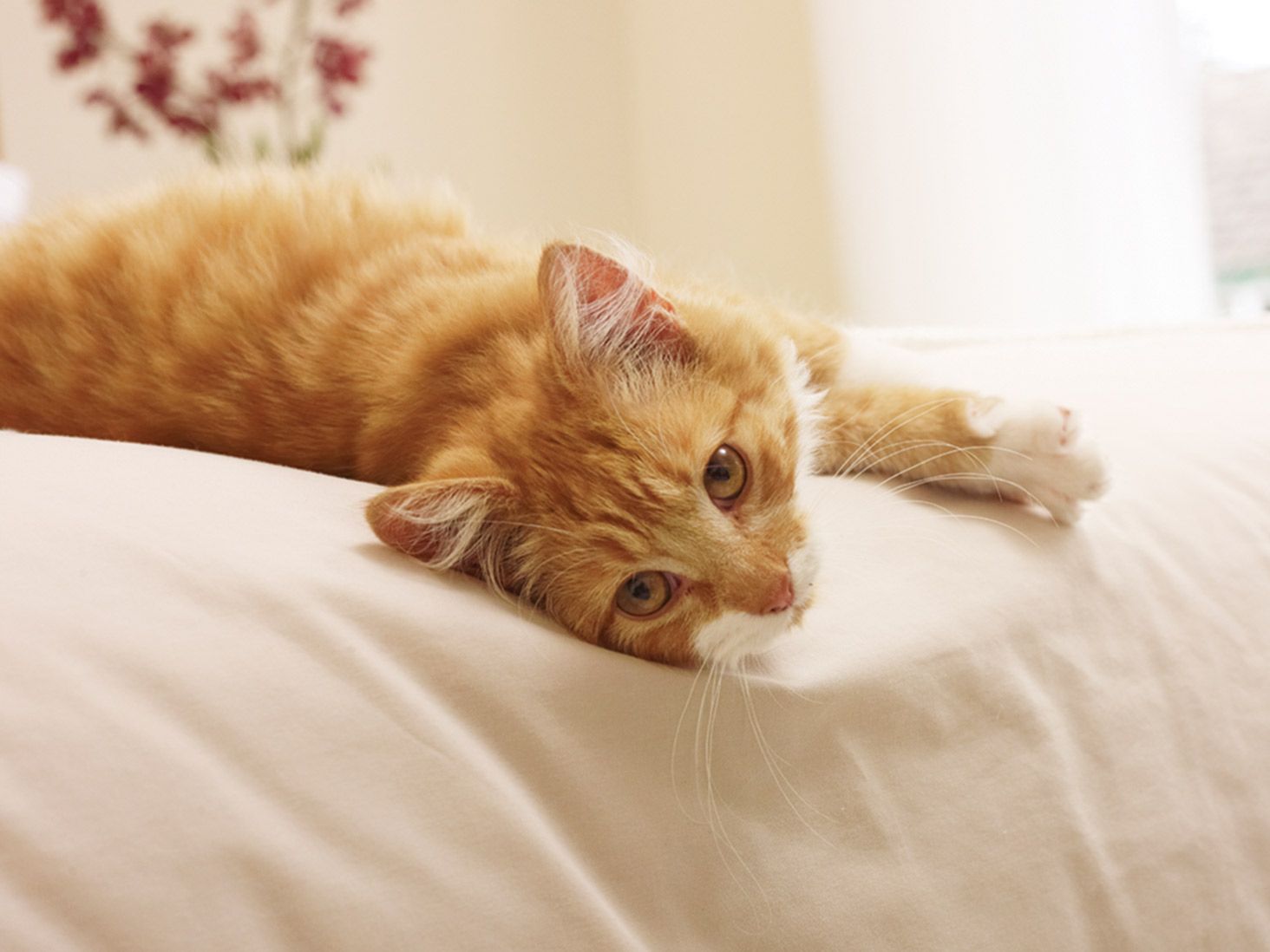
So You’re Getting a Kitten
Adopting a new kitten is a wonderfully rewarding, life-changing event. Bringing a new cat home means bringing home a curious, energetic and affectionate new friend. But getting a cat also means taking on new responsibilities. Whether this is your first cat, or just one more addition to an established feline family, you’ll want to run down the list of cat essentials to ensure your new kitty will be healthy, safe and happy in her new home.
The Basics: Cat Supplies You’ll Need
Before you bring your little buddy home, you’ll want to stock up on kitten essentials. So what do kittens need? It can seem a little daunting, especially if this is your first kitten, but like so many things in life, it’s easiest if you start with the basics. You’ll want to be sure you’ve got everything you need to fulfill your kitten’s basic needs: food, water and a place to use the bathroom.
Cat Food
For many first timers, cat food is the first item checked off the new kitten checklist. Cat food comes in two basic forms: wet, which is usually a canned pâté or shredded product; and dry, which is typically small kibble available in a variety of shapes and flavors.
Depending on your cat’s age, body type, breed, and specific health needs, she may benefit from one food type more than another. For long-term dietary needs, it’s best to check with your veterinarian for food recommendations.
Some cats and kittens can be picky eaters, especially when moving into a new home, so it can help to have a few options on hand in case your new friend turns her nose up at the first meal you offer.
Cat Feeders
Kittens can pack a bewilderingly big appetite into a tiny body. Like any growing baby, a kitten needs adequate nutrition and a lot of it to ensure her body and mind develop to be healthy and strong. In fact, there are many foods available today that are created specifically for growing kittens.
If you’re having trouble keeping up with your kitten’s voracious appetite, or you just have a busy schedule, an automatic pet feeder can be a huge help! These convenient products come in a range of options from simple gravity-fed designs to smartphone- and voice assistant-enabled electronic feeders that allow you to set mealtimes days in advance, ensuring your cat never has to miss a meal (or come bug you for food at 4 in the morning!)
Pet feeders are also great because they help you manage precise portion control, which helps prevent overeating and obesity.
Water
Just like us, cats need consistent access to fresh, clean water for a healthy life. For some cats, a simple bowl of water, refilled daily and washed a few times a week may suffice. Unfortunately, many cats are extra persnickety when it comes to their water supply and end up not drinking enough water as a result.
Cats that don’t get enough water can develop serious health issues, including common urinary and kidney problems. The good news is that there are effective ways you can persuade your cat to drink more water.
Cat Fountains
Cats prefer moving water – in fact, many cat owners find their kitties irresistibly drawn to dripping faucets and running sinks. The solution is simple: Pet fountains are handy cat essentials provide a constant supply of fresh, flowing, filtered water 24/7. Pet fountains are available in a variety of designs and many have adjustable flow options to entice even the pickiest felines.
If a pet fountain wasn’t already on your list of cat items to get, consider adding it – your cat will thank you!
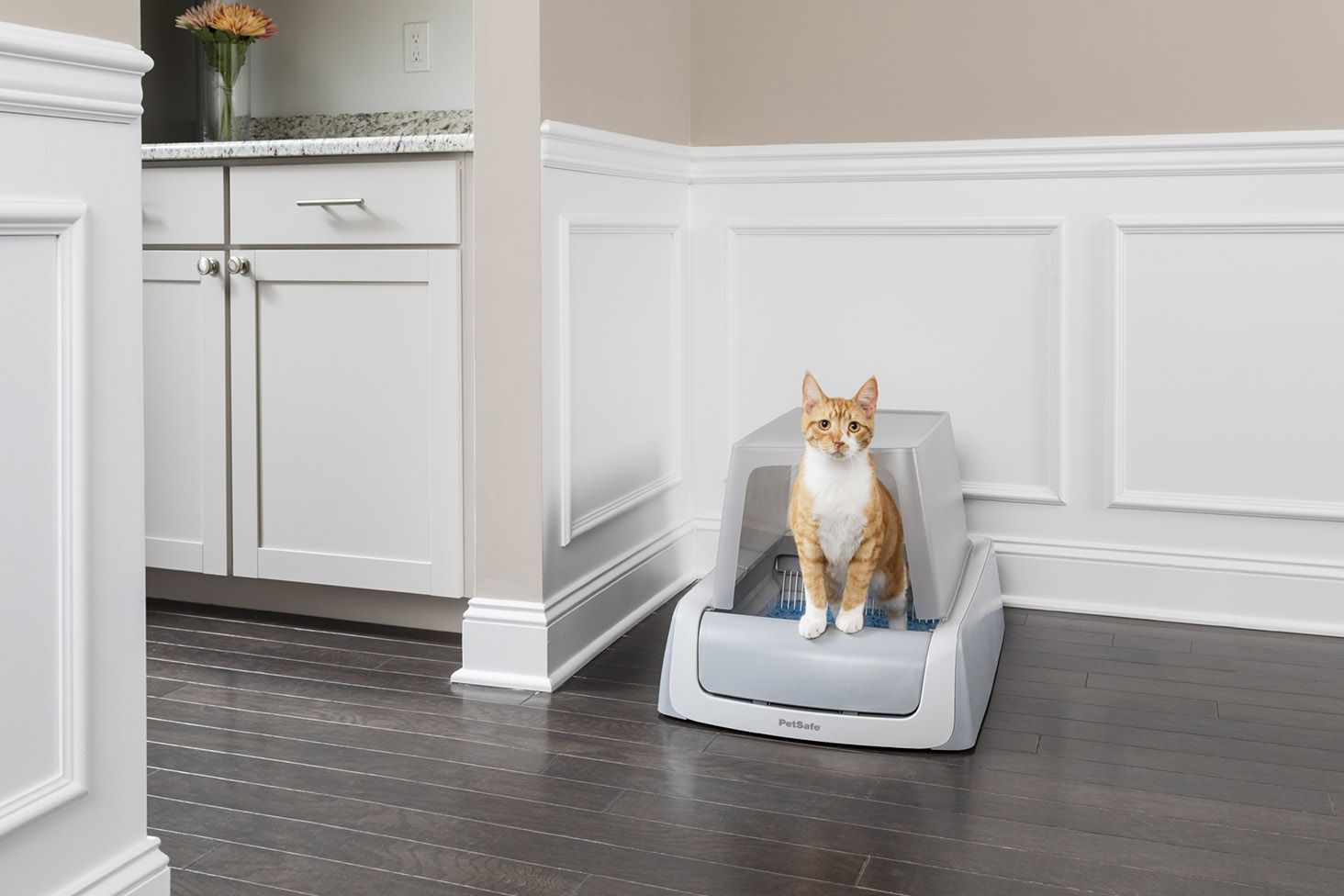
Litter Boxes
Just as a new baby needs diapers, a new cat or kitten needs a place to do her business. There are a great variety of litter box types, shapes and sizes available, and it pays to do some research before making a purchase.
For a new kitten, you’ll want to keep in mind your cat’s size as she grows. Very young kittens may do best with simple training pads, also known as potty pads or “pee pads,” but you’ll want to start getting your kitten acclimated to using a true litter box within the first few months she is home.
- Basic Litter Pans: Because of their short stature and adorably stubby legs, young kittens sometimes do well starting with simple “pan” style litter boxes that have low sides and a wide area for kitty to explore before she picks the perfect spot to make a deposit. Some litter boxes come with covers or hoods that offer privacy at potty time too. While basic litter pans can be a good place to start with training your kitten, you’ll want to think about your cat’s needs as she grows up, too.
- Self-Cleaning Litter Boxes: As your cat settles into her new home, you’ll start to understand that you’ve got a choice ahead of you: do you want to manually dispose of her used cat litter several times a week, every week? This is not a chore most cat lovers enjoy – of all cat products, the litter box is traditionally the one that cat parents consider a necessary evil. Thankfully, the world of litter box technology has seen a renaissance since the 1990s, and they keep getting better! Self-cleaning litter boxes are now available that eliminate the chore of scooping and minimize the offensive odors that litter boxes tend to produce. Because of this, many cat lovers even swear by using a self-cleaning litter box for multiple cats. Versions of the self-cleaning cat litter box are available with removable covers for the more discerning feline, too. While automatic self-cleaning litter boxes are generally not recommended for use with kittens under 6 months old, it’s still a great idea to get one and simply leave it turned off until your cat reaches 6 months. In the meantime, simply scoop as you would a traditional litter box, and your cat will already be acclimated when you’re ready to start using the self-cleaning function.
- Smart Litter Boxes: If you think the idea of a self-cleaning litter box is intriguing, consider that there are now litter boxes that actually connect to your smartphone! A smart litter box can notify you when your cat has used the bathroom and help you track how frequently she goes. Why would you want this information? Due to the prevalence of urinary issues in cats, changes in potty habits can be an early warning sign for more serious health concerns. If you’re the forward-thinking type, consider a smart cat litter box to help you keep a close eye on the details of your cat’s health. Smart litter boxes can also tell you when it’s time to replace litter trays, and even be set up to automatically order more to be shipped to your front door.
Cat Litter
There is a wide world of cat litter options out there, and how to navigate this world is one of the most useful things to know before getting a cat. The type of litter you need may depend on the type of litter box you choose, but for most traditional litter boxes, you have several options.
- Clay litter: This is one of the oldest and most commonly used litter types. Dry clay particles absorb moisture effectively, but it can be quite heavy to move and carry, especially when saturated with waste. It also tends to be dusty when dry and muddy when wet. Despite these drawbacks, it remains popular because it is one of the most affordable litter types. Most clay litter is clumping, meaning it forms scoopable clumps where your cat has defecated and urinated, but non-clumping clay litter is available too.
- Pine and paper litters: These are made of natural plant fiber. These are generally more eco-friendly than other litter types, are lighter-weight when dry and are especially soft on cats’ paws. However, these fiber litters don’t offer much odor control and can be messy to clean up as they often stick to litter box surfaces when damp.
- Crystal litter: Also known as silica litter, crystal litter is made of porous crystals that are unmatched at their ability to absorb moisture. Crystal litter quickly absorbs urine and dries out solid waste to minimize odor. In fact, crystal litter has been demonstrated to be five times more effective than traditional clay litter at eliminating odors. Crystal litter is also essentially dust-free, meaning there is no irritating dust to breathe or messy tracking on the floor. While crystal litter tends to be more expensive than other litters pound for pound, its efficiency and efficacy are impossible to beat! Some self-cleaning litter boxes even provide convenient litter trays, so you don’t have to buy litter in bulk or measure it out. Once you’ve lugged a heavy sack of clay litter into your house, you’ll understand why this is so beneficial!
Additional Kitten Essentials
So we’ve covered the basic cat needs– but besides food, water, and place to potty, what do cats need to be happy? Cats, and especially kittens, are naturally inquisitive animals who love to explore their environment and keep their minds engaged. And at the end of a long day (or night!) of fun, there’s nothing like a good cat nap. There’s plenty of fun cat stuff available to help you fulfill all these needs.
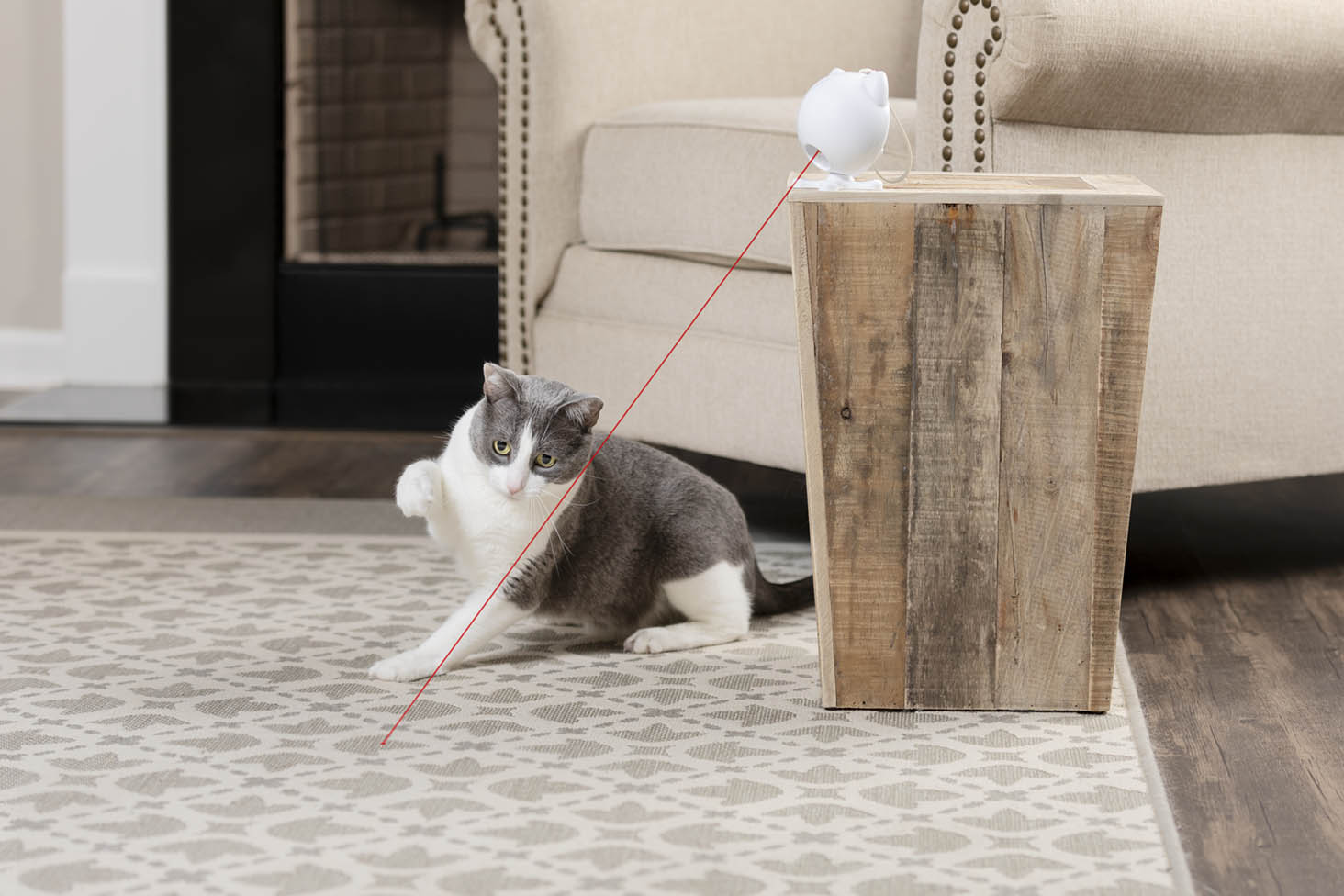
Cat Toys
Romping on the floor. Chasing a piece of string. Batting at a passing butterfly. Classic kitten stuff, right? Play is a natural part of a young animal’s life, and it helps them learn how to interact with other animals and navigate their world.
For our beloved housecats, toys can be a great way to focus playful instincts and keep your kitty engaged and out of trouble.
Cat toys have come a long way from the traditional feathers and bells on a string. While plush mice scented with catnip will always be a staple among kitten supplies, there are plenty of more innovative cat toys available today that are designed to encourage longer play time.
- Laser toys: The advent of safe, inexpensive laser pointer technology changed the cat toy game forever. Millions of cats are enthralled with chasing the ever-elusive red dot. While a handheld laser pointer can be a great way for you to play an active role in your cat’s indoor exercise, there are times when you can’t just sit on the sofa all day putting on a private laser show for your cat. Enter: automatic laser toys! These ingenious devices project a moving laser dot onto the floor with an unpredictable, random pattern of starts and stops. These automatic toys free you from the handheld laser pointer, meaning you can tackle chores or simply watch while your cat has a blast chasing that irresistible dot. Laser toys are a safe and simple way to keep your cat entertained while you’re busy. Some even have automatic timed settings so your cat can enjoy unexpected bouts of playful exercise while you’re away. Laser cat toys are a great option for homes with multiple cats too.
- Treat- and food-dispensing toys: These nifty cat supplies are another great way to entertain your feline friend. These toys usually have a compartment you fill with treats or kibble, and then as your cat plays, morsels fall out of the toy here and there to encourage continued interaction. These toys are especially engaging for food-motivated cats who get impatient between meals. Food-dispensing toys can also help you keep your cat healthy. For cats who tend to eat too quickly and then throw up their meal, (a surprisingly common issue), a toy that slowly dispenses small amounts of food during play can be a perfect solution. Combining active play with mealtime also ensures your cat gets some exercise in to earn her calories, which helps prevent obesity.
Scratching Posts
One thing many first-time cat owners quickly learn is that those little claws can do a lot of damage! Like play, scratching various surfaces in the environment is a natural and healthy activity for cats. The downside to this is that our furniture, floors and walls are often the target of this behavior.
Scratching posts and scratching pads are textured cat products that help redirect this behavior so cats can still act out their instincts without damaging your home. These products come in a variety of shapes, structures and materials, from simple corrugated cardboard to wood and foam wrapped in carpet or natural rope fibers.
If you find your cat is an enthusiastic scratcher, she may appreciate a selection of different surfaces to choose from, for instance, a flat carpeted pad in one room and a rope-wrapped wooden post in another.
Cat Towers
Another common natural behavior for cats is their tendency to climb to high places. We’re all familiar with the cliché of the kitten stuck in the tree after she climbs too high.
Inside your home, this can occasionally become an issue when your cat gets up onto places like windowsills, shelves and refrigerators. To redirect this behavior, consider providing a cat tree or cat tower. These pieces of “cat furniture” are often composed of wood or particle board covered in soft carpeting.
Placing cat furniture near a window can give your cat a comfy perch from which she can watch activity outside in your yard or neighborhood. To create the cat version of TV, place some bird feeders outside the window and attract some feathered performers to intrigue and entertain your feline friend. In fact, you’ll often find that getting a kitten makes you notice backyard wildlife you never did before!
Cat Beds
Cats love to play, they love to scratch, and they love to watch the world from high places. But more than any of these, perhaps, cats love to sleep! In fact, on average, cats tend to sleep 15 to 20 hours a day. Again, this is a perfectly natural behavior for cats (even lions spend most of their time asleep) and one that you should encourage to help your cat thrive.
What do cats need to get the most out of this daily activity? While some cats can sleep almost anywhere, (including on your pillow), if you’re bringing a new cat home, it’s a good idea to provide a dedicated cat bed.
A variety of comfortable bed styles are available, including some shaped like caves or burrows so your kitten can get extra cozy. Soft blankets are recommended too, especially for small kittens, who tend to get cold more easily. If you have multiple cats, they may end up snoozing together, but it’s best to provide at least one bed per cat.
Cat Carriers
When it comes to taking your cat to the vet, to the groomer, or on a trip, a good cat carrier is a must-have on your list of cat supplies. Cat carriers can be soft-sided or rigid, with some of the most common designs being hard plastic with metal grated doors.
A cat carrier will provide the security your cat needs when leaving your home and in busy places like your veterinarian’s waiting room. Cat carriers can also double as a cozy shelter for your cat around the house.
Placing the carrier in a secluded corner of your home with the door removed and some cozy blankets inside can give your cat some privacy when she needs it and will help acclimate her to the carrier, so she enters it readily when it’s time to go for a ride.
As any veteran cat parent will tell you, getting a cat into her carrier is much easier for everyone involved if she’s had time to get comfortable with it beforehand!
Health and Safety Tips
In addition to considering the common cat items already discussed, there are a few important health-related things to know before getting a cat. For many pet parents learning with their first cat, these can come as a surprise.
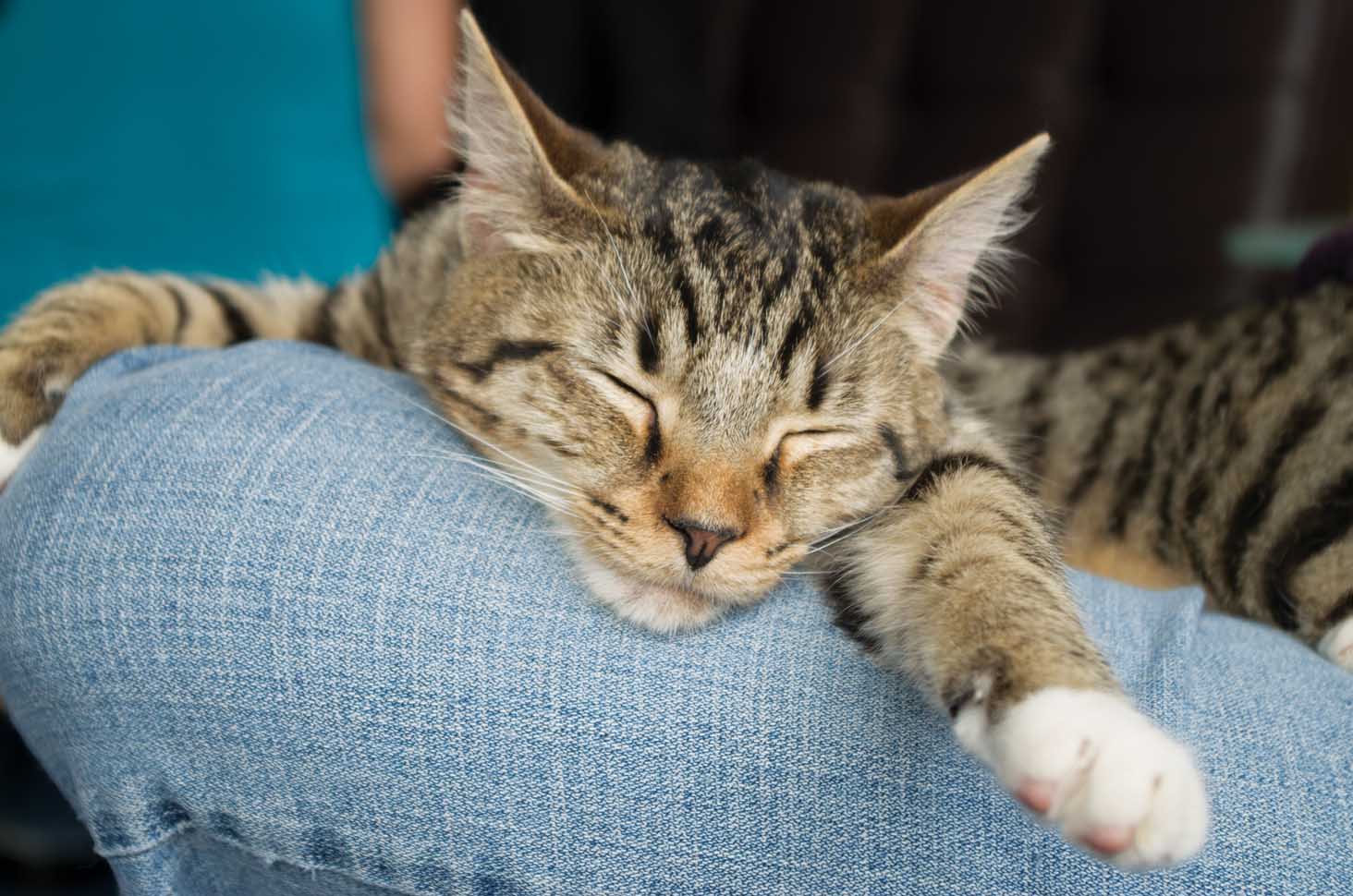
Cat Acne
Cat acne is one of those quirky cat things that only “cat people” seem to know about. These itchy bumps can appear on your cat’s skin, especially around her chin and muzzle. Veterinarians don’t have a complete understanding of all the causes for cat acne, but studies suggest there is a connection with plastic water or food bowls.
Not all cats react to plastic, but it may be best to choose cat products made of something like ceramic or stainless steel to minimize the risk. Luckily feeders, fountains and bowls are readily available in a variety of different materials.
Watch those Whiskers
Whiskers are not only cute, they’re an essential part of what makes a cat a cat! These wonder organs are amazingly sensitive to help cats get around in tight places and even in the dark.
But because whiskers are so fine-tuned to touch, many cats are hypersensitive about letting their whiskers brush against surfaces.
Bowls with deep or narrow openings where a cat’s whiskers touch the sides can actually prevent a cat from eating or drinking comfortably. The best way to avoid this is to offer eating and drinking surfaces that are wide and shallow, and to avoid placing these in corners or against walls.
Collars and Chips
When asking ourselves “what do kittens need?” the term “breakaway collar” is probably not one of the first things to pass into first-time cat parents’ heads. However, these cleverly designed collars can literally be a lifesaver for your cat!
A collar can be a great way to help keep your cat safe because it can hold her identification tags, her rabies vaccine tag and more. So if she ends up away from home, anyone who picks her up can get her back to you.
But because cats are so likely to sneak into tight spaces, like beneath furniture or into hedges, they run the risk of snagging their collars on a branch, corner, etc. This can spell disaster, getting a cat in serious danger if she gets caught and can’t escape! Breakaway collars are designed with a weak point, so the collar stays on during normal wear, but in a struggle, the collar will break loose, so you’re cat isn’t in danger of getting stuck.
If you want to avoid a collar altogether, a microchip is the way to go. These tiny, harmless tags are implanted under the skin by a veterinarian. Microchips can be scanned by vets and shelters, quickly and reliably providing your contact info to anyone who finds your cat so you can be reunited sooner.
There are even pet doors designed to recognize your cat’s microchip, so only she can come in and out!
Hairballs
On the list of “gross cat stuff”, hairballs are probably near the top for most cat parents. Hairballs form when your cat swallows too much of her own fur while grooming. Because a cat’s tongue acts like a hairbrush, it’s quite efficient at collecting loose hairs.
The majority of this hair is passed in the cat’s stool, but when too much hair enters the gut at once, it can form a dense mass that the cat must cough up. So while cats are regularly admired for their fastidious grooming habits, a downside to this compulsively clean lifestyle can be those slimy wads of fur your cat vomits up onto the sofa.
To prevent hairballs, give your cat a hand with her grooming! Brushing your cat regularly will remove excess hair as it is shed, preventing it from ending up in her digestive tract.
This is especially important with long-haired cats, who are nearly twice as likely to develop hairballs as short-haired breeds. Hairballs can also be a sign of excessive grooming, which can occur when your cat’s skin is irritated by factors like fleas or stress. Keep an eye on your cat’s grooming habits, and always consult your vet if you are concerned.
Preparing for Your Kitten’s Arrival
Now that you’re familiar with the essential kitten stuff every new cat parent should consider before bringing a new cat home, it’s time to talk about preparing for the big day. This involves cat-proofing your space as well as ensuring you’re all set to establish a consistent vet care routine.
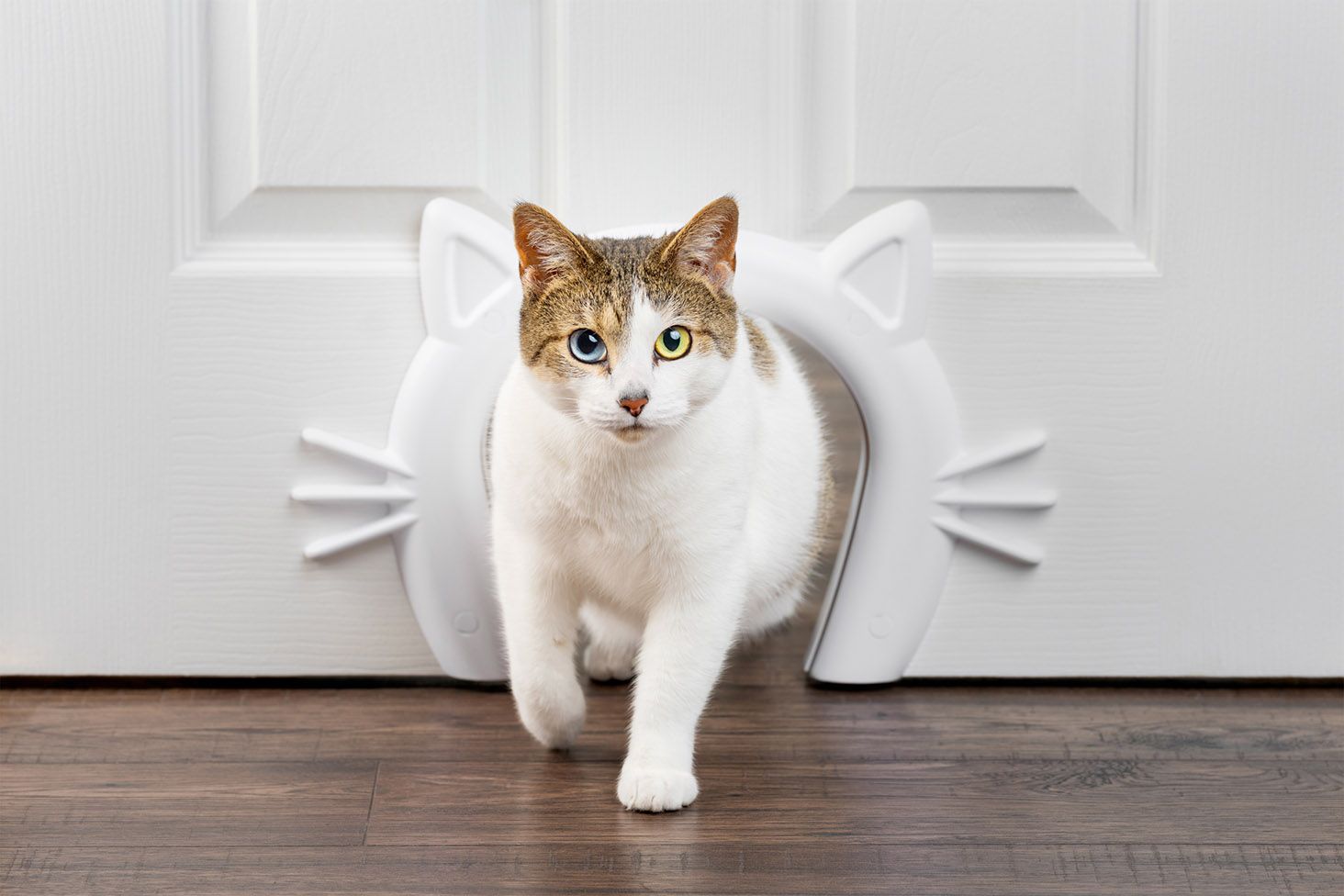
Removing Potential Hazards
Curious kittens can get into plenty of trouble around the home. In addition to redirecting her energy with fun products like cat toys and scratching posts, there are other steps you can take to ensure she stays safe. A good place to start is by doing a walkthrough of your home and identifying any situations that stand out to you as a potential risk. Common risks anyone with a cat needs to be aware of include:
- Open vents or holes in the floors or walls: Kittens can squeeze into very tight spaces!
- Gaps behind or beneath furniture: (again, watch for any tight spaces.)
- Areas with fall risks: Cats are generally agile but young kittens and certain breeds may be at higher risk of falling from elevated places like lofts or windowsills.
- Loose cords or strings: For example, dangling electrical cords or curtain pull strings; cats are often fascinated with these but can become tangled or injured if they try to play with them.
- Open windows: Open windows can be tempting for cats, so make sure windows and screens are securely closed.
- Toxic plants: Certain plants such as lilies can be poisonous to cats; if you have houseplants or are considering them, make sure to check with a vet to be sure each plant is safe to have around your cat.
- Food items: Leaving fruit, candy or other food exposed on counters or tables can tempt your cat to have a taste, so keep this in mind when storing or preparing food.
- Fragile or breakable items: Cats are notorious for knocking items like mugs and vases off of counters and cabinets, so consider putting such items away while your cat gets acclimated.
- Open trashcans, toilets, cabinets, washer/dryer, etc.: Once more, if there is a small space accessible in your home, assume your cat will find her way in there at some point! Keep lids and doors shut on any little space she might try to explore.
Cat-Proofing Furniture
In addition to protecting your kitten in her new home, you’ll want to consider protecting your home from her little claws. While scratching posts can help redirect her scratching behavior, some cats simply can’t resist digging their nails into your loveseat or coffee table.
There are a number of ways you can prevent this, including wrapping furniture legs with tape or aluminum foil, or applying commercially available deterrent sprays.
However, these don’t always work, and they don’t prevent other unwanted cat things like “spraying,” when cats mark their territory with a quick spray of urine on vertical surfaces. That’s where avoidance training comes in.
Avoidance Training
For long-term cat-proofing, nothing beats training your cat to change her behavior. Avoidance training can be accomplished in different ways. Some cats take well to clicker training.
However, some training methods often have limited success because they require you to supervise your cat constantly and respond consistently to every instance of unwanted behavior. A much easier and more effective method is through use of an automatic avoidance training device.
These helpful products use motion-, proximity- or pressure-sensing technology to detect when your cat has entered an off-limits area. When this happens, the device delivers a “correction,” an abrupt stimulus that surprises her and interrupts her behavior.
Effective forms of correction employed by avoidance devices range from a quick puff of air to a harmless static stimulation. These avoidance training products are great because they work 24/7, even when you’re busy, asleep, or away from home. The more consistently your cat is corrected for unwanted behavior, the sooner she’ll learn how to behave in a way that is safe for her and for your furniture.
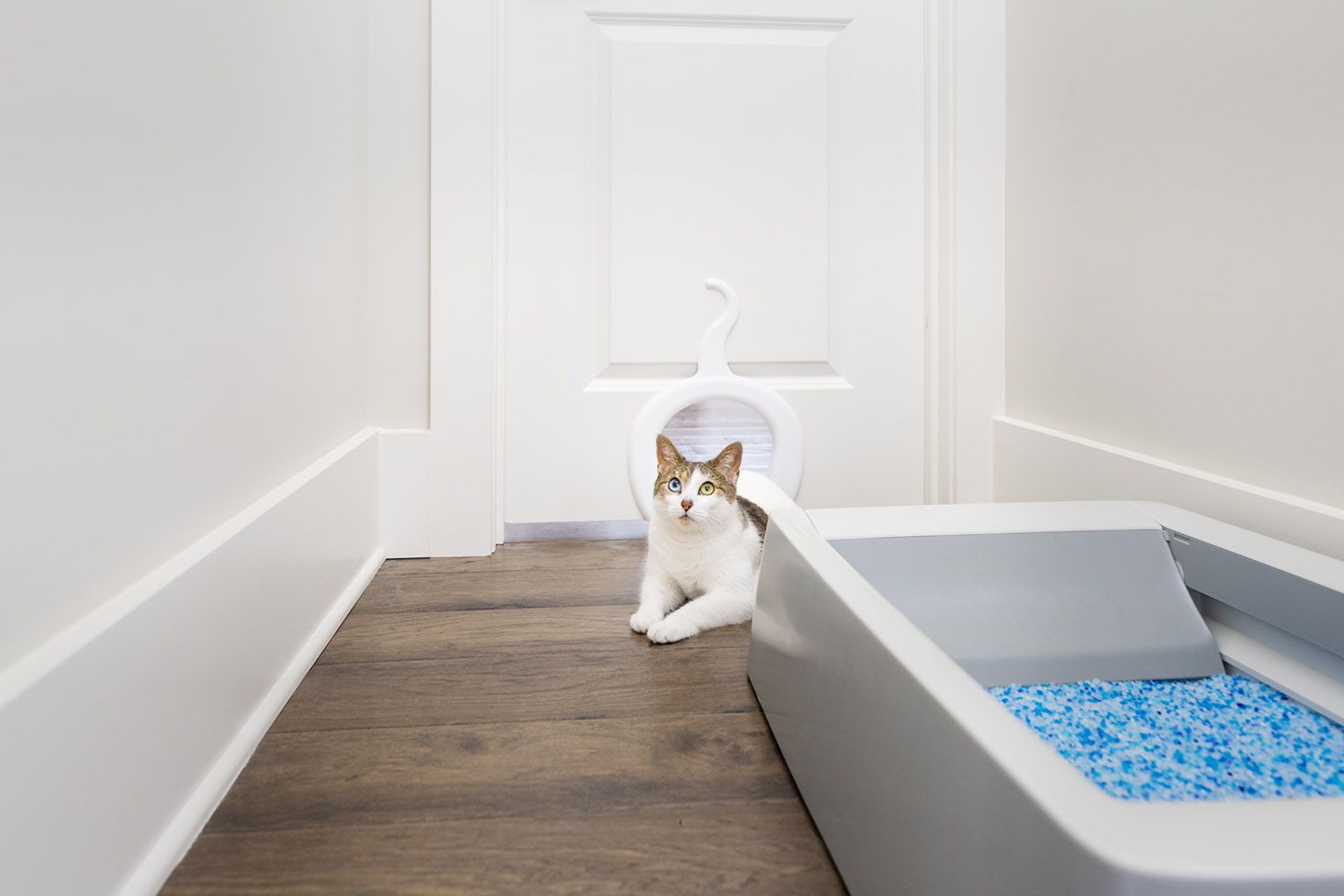
Providing Access and Privacy
If you have dogs or small children, be aware that these family members may be inexplicably drawn to your cat’s food or to her litter box. Unappetizing as it may seem, pups and toddlers sometimes can’t resist playing in the “sandbox” where your cat does her business.
A reliable solution to this all-too-common problem is a cat door. Installing a cat-sized pet door in your wall or into an existing door within your home can allow your cat to pass in and out of the room where her litter box and food stays, while keeping curious kids and canines out. Cat doors come in a variety of styles for different wall and door materials and thicknesses.
Some simply provide an open “hallway” for your cat, while others seal with locking flaps. Giving your cat her very own door can offer privacy while providing access to her favorite places.
And speaking of favorite places, consider pet stairs or a pet ramp to help your cat get up and down from chairs, sofas, beds and more. Cats are naturally spry, but giving them a boost up and down will help preserve their joints in the long run.
Finding a Vet
In addition to prepping your home and stocking up on kitten supplies, you’ll want to get set up with a local veterinarian. It can be helpful to speak with the vet even before you bring your first cat home – many vets offer digital or printed materials available to help educate and prepare you for your new pet.
Request an appointment with your vet as soon as possible once you’ve brought your cat home; this way you can establish a basic health profile with the vet and get plans lined up for important medical services like vaccinations, parasite prevention, dental care, spay/neuter and more.
To find a local vet practice that’s right for you and your cat, try checking online and reading reviews. Friends and family in your community who have had cats can often recommend vets too. Routine vet visits are critical to ensuring a long, healthy life for your cat, so don’t wait! Reach out to a local vet to establish a relationship as soon as you’ve decided to add a feline member to your family.
Welcoming Your Kitten
So the big day is finally here! Bringing your kitten home for the first time can be an exciting experience for everyone involved. Keep in mind that your cat will be plunged into an all-new environment with lots of stimulation. Take it slow, take it easy, and take it one step at a time to ensure she is comfortable as she acclimates to her forever home.
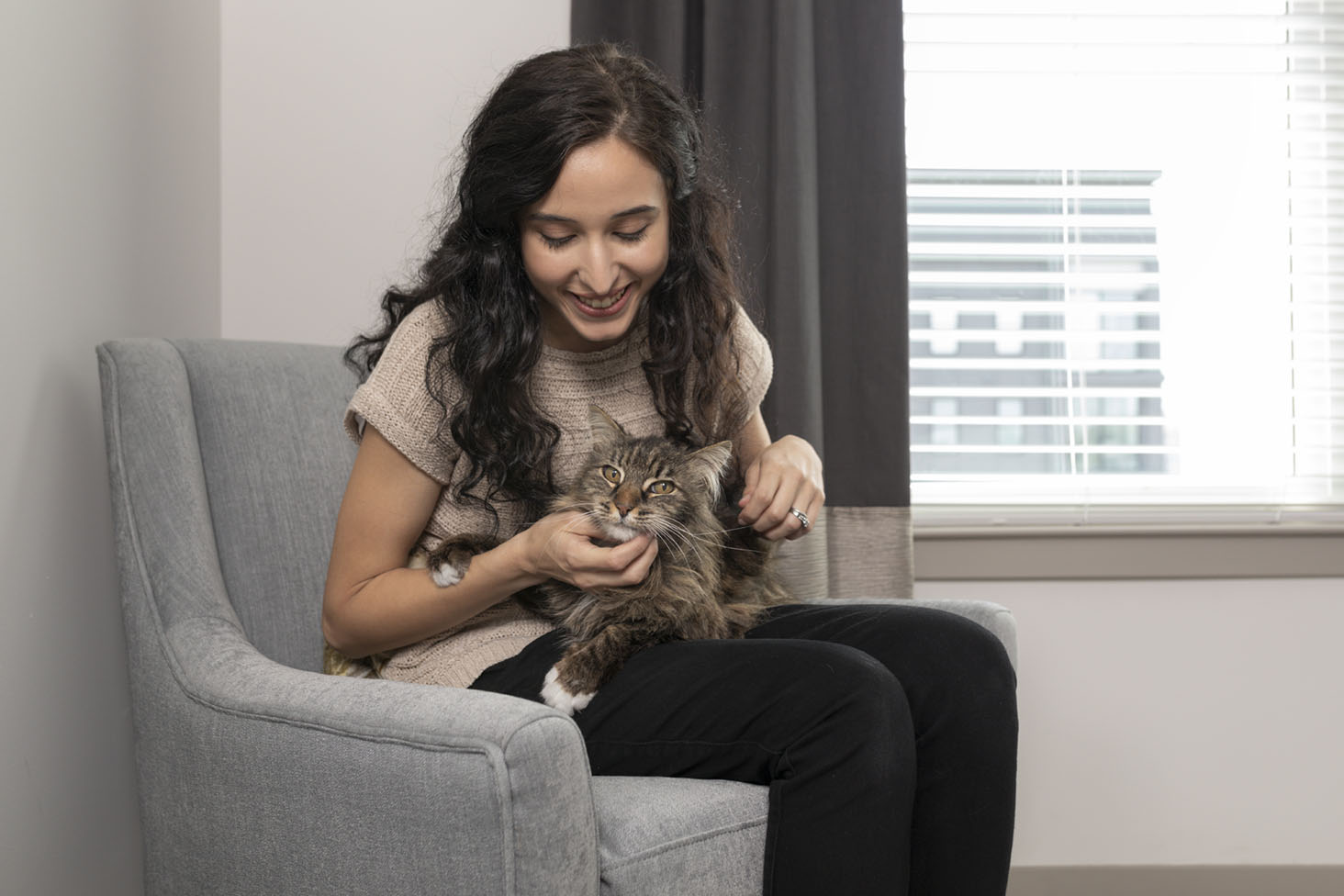
Showing Your Kitten Around
As with any new home, you’ll want to start with the grand tour. Slowly bringing your kitten from room to room in your home will help her get familiarized with sights, sounds, smells and more in her new space. Remember to do so gradually, spending a few minutes in each space and watching your cat to see how she reacts. This can be done in a carrier, or in your arms.
If you feel comfortable, and your cat seems relaxed, you can try setting her down on the floor in each cat-proofed room. Let her explore the areas you’d like her to spend time in and encourage her to follow you from room to room if she seems willing.
Cats are natural explorers with an instinct for establishing territories, so it won’t take her long to develop a mental map and find her way around on her own.
Introducing Other Pets
One of the most exciting parts of bringing a new kitten home is introducing her to the rest of the family. This means other cats, dogs, children, and any other people or animals who will be sharing her home.
It can’t be emphasized enough that you should approach this slowly. Make sure all interactions are supervised and that animals and young children are restrained in a way that keeps everyone safe.
A great way to introduce your new cat to toddlers or to other cats is inside a carrier. This helps the kitten feel secure and prevents anyone from getting up close and personal before the kitten is ready.
Make sure to explain to children how fragile and nervous the kitten might feel. Teach children the dos and don’ts of handling or playing with their new buddy. Try introducing one family member at a time and be sure to observe each introduction closely for signs of distress.
If you have a dog, be extra careful and try introducing your kitten through a solid barrier like a baby gate or a carrier. Dogs can sometimes behave unpredictably when first introduced to cats, and even the gentlest dog can accidentally injure a kitten simply due to differences in body size.
Of all the steps in your preparation, it is perhaps most critical to be patient, watchful and cautious as you introduce your cat to other pets. If you notice any persistent signs of distress or aggression, such as growling, hissing, swatting or lunging, consult with your veterinarian about how best to approach the issue.
When all goes well, the new kitty will gradually be accepted as a playmate and lifelong companion for every member of your family.
The First Night
You’d think after such a big day of introductions and new places, your kitty would be ready to snooze all night. Though she’s likely to zonk out here and there, it’s quite possible she’ll be overcome with curiosity throughout the first hours and days in your home.
While older cats are often more likely to want to hide for the first few days, kittens are generally brave explorers from the get-go. During this time, it’s important to supervise her as much as you can, not only to keep her out of trouble, but also to see how she’s adjusting to her new environment.
Encourage her to be comfortable with play time and treats. Carry her to the window to watch the world go by outside. Maybe even invite her up to nap on your lap while you stream a movie. When you’re ready to hit the hay on those first few nights, make sure she is in a secure place like her carrier, where she can safely dream of the adventures you’ll soon share together.
Conclusion
Welcoming a cat into your home takes some preparation and patience, but all that hard work will pay off when your new kitten falls asleep comfortably in your arms or next to your head for the first time. There’s nothing quite as peaceful as hearing contented purrs from that sleepy, happy little ball of fur. As your cat grows up, PetSafe® is here to provide you with quality cat essentials and expert support to help you keep her healthy, safe and happy for a lifetime of love.

